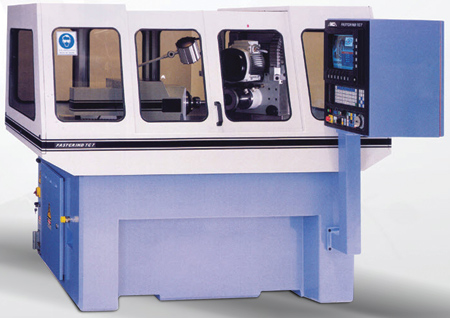
"FastGrind TG7 with a polymer concrete base, which had eight times the rigidity and dampening of conventional cast iron bases," reports ANCA.

What do tool and cutter grinders and buildings have in common? The importance of having a solid foundation.
An essential component of achieving good accuracy and repeatability when grinding a cutting tool is the base. Having a stable foundation for a machine is paramount to achieving stable production. As part of ANCA's commitment to vertical integration, in the late 1980s Pat McCluskey, Co-Founder and Managing Director of ANCA, decided to replace the bases that were then outsourced with an ANCA-designed and manufactured base.
McCluskey's research was conducted primarily in Europe in conjunction with Aachen University who had carried out some research in polymer concrete in machine tool applications. He worked with German and local consultants to develop ANCA's recipe for concrete base manufacture. The base molding technology it developed has since been an important part of the rigid ANCA bases.
The first base was poured in late 1989. Further pouring and testing followed until everyone was fully satisfied. "Now called ANCAcrete, this technology would provide the best possible foundation for precision CNC grinders, reducing vibration and increasing the overall rigidity of the machine," said an ANCA spokesperson.
Since 1991 ANCA has been using the polymer base technology which forms the stable foundation base of all ANCA machines. "Customers often ask us to explain the benefits of polymer concrete and we explain that polymer concrete by its very nature has a high thermal mass, so our bases are good at absorbing a lot of heat," said the spokesperson.
That means that throughout the production processes, growth and contraction are very controlled and it takes a long time-which means that the process is very stable. The second main part of polymer concrete is that when ANCA designed the mix over 20 years ago, it was made to mimic the expansion thermal coefficients of cast iron very closely. This means that as the machines heat up and cool down, ANCA can control the expansion and contraction of the machine-which in turn, provides control over the production processes to make sure that the machine aligns to how ANCA wants it to react.
"Between the large thermal mass, the very closely linked thermal expansion coefficient to cast iron and the vibration absorbing characteristics, ANCAcrete significantly contributes to the overall rigidity of the machine. For our customers this translates into highly accurate tools with a superior surface finish," said the spokesperson.
"ANCA has fully embraced the benefits of vertical integration and designs and manufactures the complete machine, including building the CNC, precision motors and spindles, and of course our ANCAcrete polymer concrete bases, in-house."
For more information contact:
ANCA Inc.
31129 Century Drive
Wixom, MI 48393
248-926-4466
usainfo@anca.com
www.anca.com